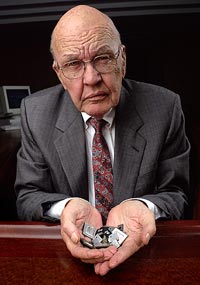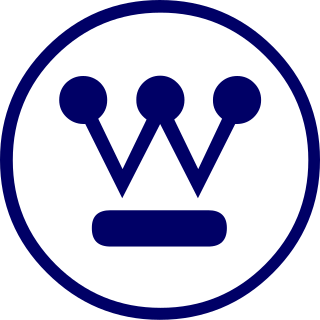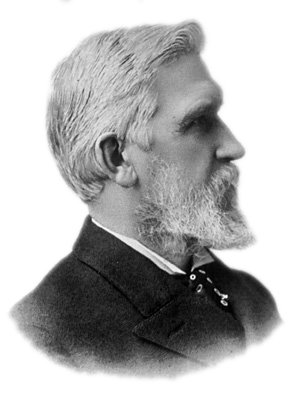
Jack St. Clair Kilby was an American electrical engineer who took part, along with Robert Noyce of Fairchild Semiconductor, in the realization of the first integrated circuit while working at Texas Instruments (TI) in 1958. He was awarded the Nobel Prize in Physics on 10 December 2000.

The Westinghouse Electric Corporation was an American manufacturing company founded in 1886 by George Westinghouse and headquartered in Pittsburgh, Pennsylvania. It was originally named "Westinghouse Electric & Manufacturing Company" and was renamed "Westinghouse Electric Corporation" in 1945. Through the early and mid-20th century, Westinghouse Electric was a powerhouse in heavy industry, electrical production and distribution, consumer electronics, home appliances and a wide variety of other products. They were a major supplier of generators and steam turbines for most of their history, and was also a major player in the field of nuclear power, starting with the Westinghouse Atom Smasher in 1937.

Theodore Harold Maiman was an American engineer and physicist who is widely credited with the invention of the laser. Maiman's laser led to the subsequent development of many other types of lasers. The laser was successfully fired on May 16, 1960. In a July 7, 1960, press conference in Manhattan, Maiman and his employer, Hughes Aircraft Company, announced the laser to the world. Maiman was granted a patent for his invention, and he received many awards and honors for his work. His experiences in developing the first laser and subsequent related events are recounted in his book, The Laser Odyssey, later being republished in 2018 under a new title, The Laser Inventor: Memoirs of Theodore H. Maiman.

Eaton Corporation plc is an Irish-domiciled multinational power management company, with a primary administrative center in Beachwood, Ohio. Eaton has more than 85,000 employees and sells products to customers in more than 175 countries.

Elisha Gray was an American electrical engineer who co-founded the Western Electric Manufacturing Company. Gray is best known for his development of a telephone prototype in 1876 in Highland Park, Illinois. Some recent authors have argued that Gray should be considered the true inventor of the telephone because Alexander Graham Bell allegedly stole the idea of the liquid transmitter from him. Although Gray had been using liquid transmitters in his telephone experiments for more than two years previously, Bell's telephone patent was upheld in numerous court decisions.

Simon "Si" Ramo was an American engineer, businessman, and author. He led development of microwave and missile technology and is sometimes known as the father of the intercontinental ballistic missile (ICBM). He also developed General Electric's electron microscope. He played prominent roles in the formation of two Fortune 500 companies, Ramo-Wooldridge and Bunker Ramo Corporation.

Joseph Frederick Engelberger was an American physicist, engineer and entrepreneur. Licensing the original patent awarded to inventor George Devol, Engelberger developed the first industrial robot in the United States, the Unimate, in the 1950s. Later, he worked as entrepreneur and vocal advocate of robotic technology beyond the manufacturing plant in a variety of fields, including service industries, health care, and space exploration.

NEMA connectors are power plugs and sockets used for AC mains electricity in North America and other countries that use the standards set by the US National Electrical Manufacturers Association. NEMA wiring devices are made in current ratings from 15 to 60 amperes (A), with voltage ratings from 125 to 600 volts (V). Different combinations of contact blade widths, shapes, orientations, and dimensions create non-interchangeable connectors that are unique for each combination of voltage, electric current carrying capacity, and grounding system.
The Burndy Library was one of the world's largest collections of books on the history of science and technology. It was disestablished in 2006 and its collections transferred to the Huntington Library.

Bern Dibner was an electrical engineer, industrialist, and historian of science and technology. He originated two major US library collections in the history of science and technology.
Larry F. Weber, is an American electrical engineer and businessman.

Telecommunications engineering is a subfield of electronics engineering which seeks to design and devise systems of communication at a distance. The work ranges from basic circuit design to strategic mass developments. A telecommunication engineer is responsible for designing and overseeing the installation of telecommunications equipment and facilities, such as complex electronic switching system, and other plain old telephone service facilities, optical fiber cabling, IP networks, and microwave transmission systems. Telecommunications engineering also overlaps with broadcast engineering.
The Bryant Electric Company was a manufacturer of wiring devices, electrical components, and switches founded in 1888 in Bridgeport, Connecticut. It grew to become for a time both the world's largest plant devoted to the manufacture of wiring devices and Bridgeport's largest employer and was involved in a number of notable strikes, before being closed in 1988 and having its remaining interests sold to Hubbell in 1991.
Myles W. Jackson is currently the inaugural Albers-Schönberg Professor in the History of Science at the Institute for Advanced Study in Princeton, New Jersey, and lecturer with the rank of professor of history at Princeton University. He was the inaugural Albert Gallatin Research Excellence Professor of the History of Science at New York University-Gallatin, professor of history of the faculty of arts and science of New York University, professor of the division of medical bioethics of NYU-Langone School of Medicine, faculty affiliate of the Engelberg Center on Innovation Law and Policy, NYU School of Law, and director of science and society of the college of arts and science at NYU. He was also the inaugural Dibner Family Professor of the History and Philosophy of Science and Technology at Polytechnic Institute of New York University from 2007 to 2012. The chair is named after Bern Dibner (1897–1988), an electrical engineer, industrialist, historian of science and technology and alumnus of Polytechnic Institute of Brooklyn.

The Secretary of Defense Employer Support Freedom Award is the highest recognition given by the U.S. Government to employers for their support of their employees who serve in the National Guard and Reserve. To be eligible for the award, an employer must be nominated by one of its Guard or Reserve employees, or a family member of that employee.
The Dibner Institute for the History of Science and Technology (1992–2006) was a research institute established at MIT, and housed in a renovated building (E56) on campus at 38 Memorial Drive, overlooking the Charles River.

Octavio M. "Tav" Salati was an American engineer, academic and educator. He served as Professor of Electrical Engineering at the University of Pennsylvania in the field of Electromagnetic Compatibility.
Carlos Katz is an American electrical engineer, researcher and the recipient of the 2010 IEEE award. His area of research is the properties and methods of manufacture of extruded and laminar dielectric high voltage power cables, and extension of service life of installed cables. He has written papers about the effects of water treeing on the life of cable installations.
Stephen "Steve" Trimberger is an American computer scientist, electrical engineer, philanthropist, and prolific inventor with 250 US utility patents as of August 26, 2021. He is a DARPA program manager of the microsystems technology office.

Hubbell Incorporated, headquartered in Shelton, Connecticut, is an American company that designs, manufactures, and sells electrical and electronic products for non-residential and residential construction, industrial, and utility applications. Hubbell was founded by Harvey Hubbell as a proprietorship in 1888, and was incorporated in Connecticut in 1905.














